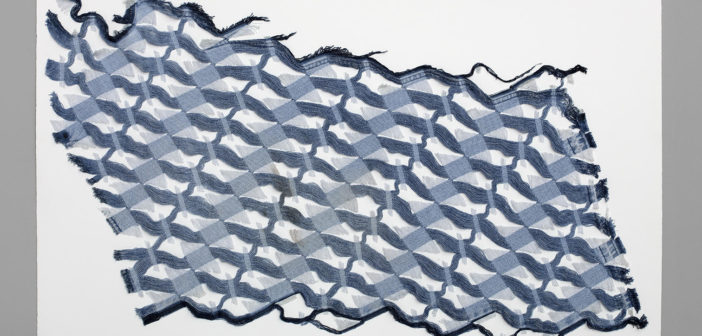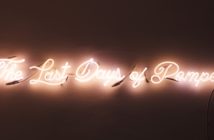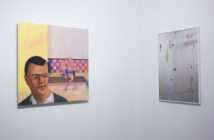Jacqueline Ott, Lisa Perez and Sean Riley conceived of It’s What You Don’t Say, now on view at The Wheeler School, over a year of conversations and visits to each others’ studios. The result is a harmonious group show, reflecting on abstraction, geometry and evidence of the artist’s hand. The three embrace their conceptual and aesthetic similarities, and it is apparent that they learned from each other, built off of their conversations and balance each other well. Importantly, each of the artists maintains a strong individual voice within the exhibition: Perez’s white grids and structural geometric sculptures, Riley’s meticulously deconstructed denim and Ott’s kaleidoscoping paintings of transparent prisms. All three artists are an affinity for grids, accentuating them them in machine woven cotton, drafting them in graphite and cutting them from paper and canvas.On the surface It’s What You Don’t Say appears to be about geometric abstraction and color and perception. But their is a strong undercurrent that investigates intimacy and humanity. Each of the artists is interested in how their hand is expressed in their final artwork.
Most apparent in this are the quavering lines of Perez’s grids and sculptures which delicately balance their organic quality with rigid geometric form. Her sculptures skitter across the gallery’s carpet, hug the walls and fold and bend with an endearing animism. Above them an assemblage of wonky grids cast mysterious colored shadows on the wall behind them. These colored shadows feel like a rephrasing of a question I often see asked by Perez’s work. They push at the line between the two and three dimensional, where drawing and painting end and where sculpture begins. This duality of dimensions seems to be as equally as pressing as the duality of where human hand meets the meticulous realm of precision and structure.
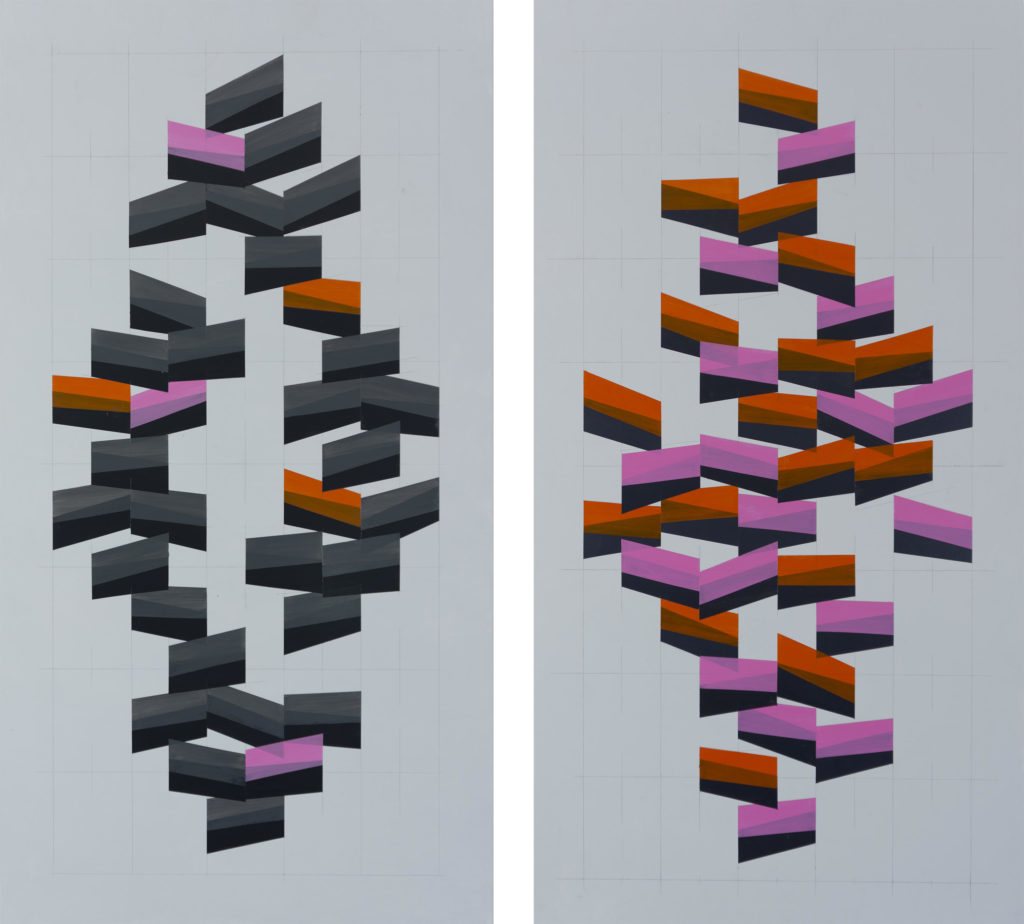
Jacqueline Ott, unhand the smooth 09, 2017. Acrylic on komatex. 2 panels each 45” x 24”
Just as interested in this last duality, Ott hides her hand more subtly in brush strokes and the occasional erasure. Her geometric paintings are based off grids drawn in graphite with a straight edge, as close to precise as possible. On close inspection the imperfections are made available: a line x-ed out, color abbreviations winking at us through transparent acrylic washes and most charmingly, a tiny handwritten “no” next to an abnormality in the underlying structure. These marks layered under bold colors and exacting shapes, hidden in plain sight amongst the lines of the grid come across as earnest indications of the human that made them.
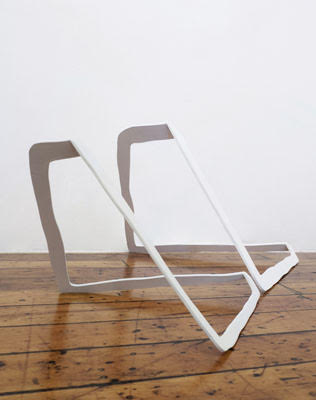
Lisa Perez, Atemporal Flux, 2017. Paint on wood, dimensions variable.
Riley’s work adds a different tone to the grouping. Unlike Ott and Perez, Riley is using a found material. On first read one might think they are weavings, but the opposite is in fact true. They are un-weavings, fabric deconstructed to reveal new geometries, intricacies, and even histories in the case of one work where a stain remains in the weft. The fabric is one that we are all familiar with but which Riley makes feel exotic. While most of the compositions are horizontal, the one vertical has a shape that will reveal itself to anyone who has folded laundry or has a background in textiles. It is an unmistakable pant leg. Using his father’s old jeans, Riley has unfurled prismatic tessellations in the faded indigo. These once common place pants take on the qualities reminiscent of traditional Japanese textiles.
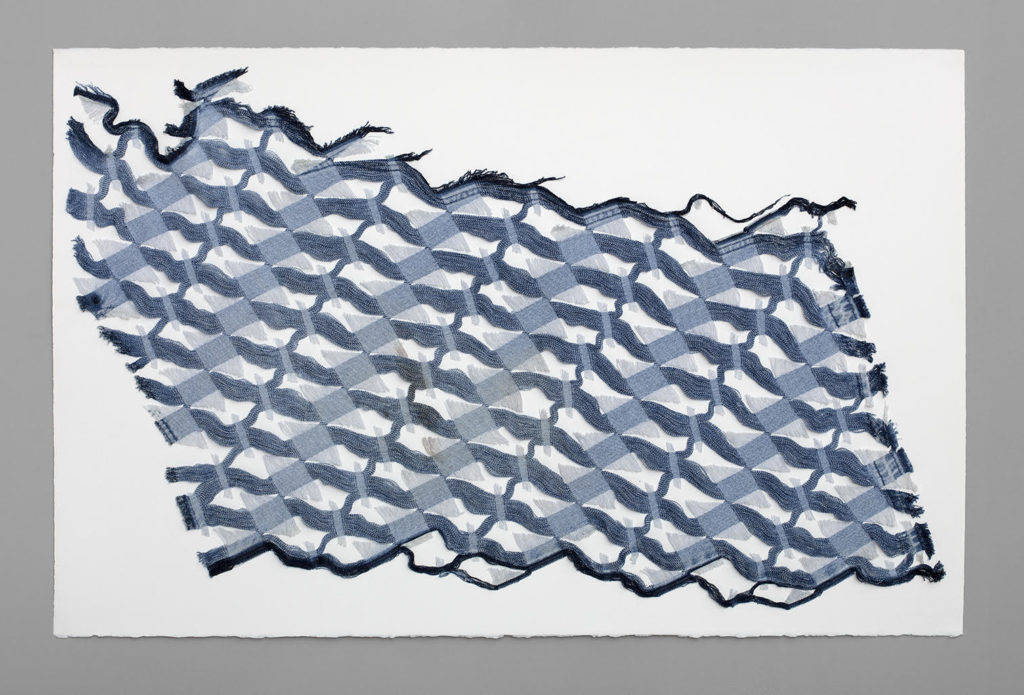
Sean Riley, (de)Weave X, 2016. Inherited denim fragment with weft removed by hand, sewn to paper, 26” x 40".
The grid is characterized as impersonal, often to the point of being de-humanising but Ott, Perez and Riley make a convincing argument against this interpretation. Ott embraces her humanity within the grid while Perez shows us the grid and the imperfections of the human hand can create their own symbiosis and Riley brings reflection and intimacy into the act of emphasizing the diagonal grids that were once his father’s. Together these three bring honesty, humanity and tenderness to geometry, elements that were stripped from artworks in the era of Minimalism, but which now feel more important than ever.
It’s What You don’t Say is on view until November 8th.

